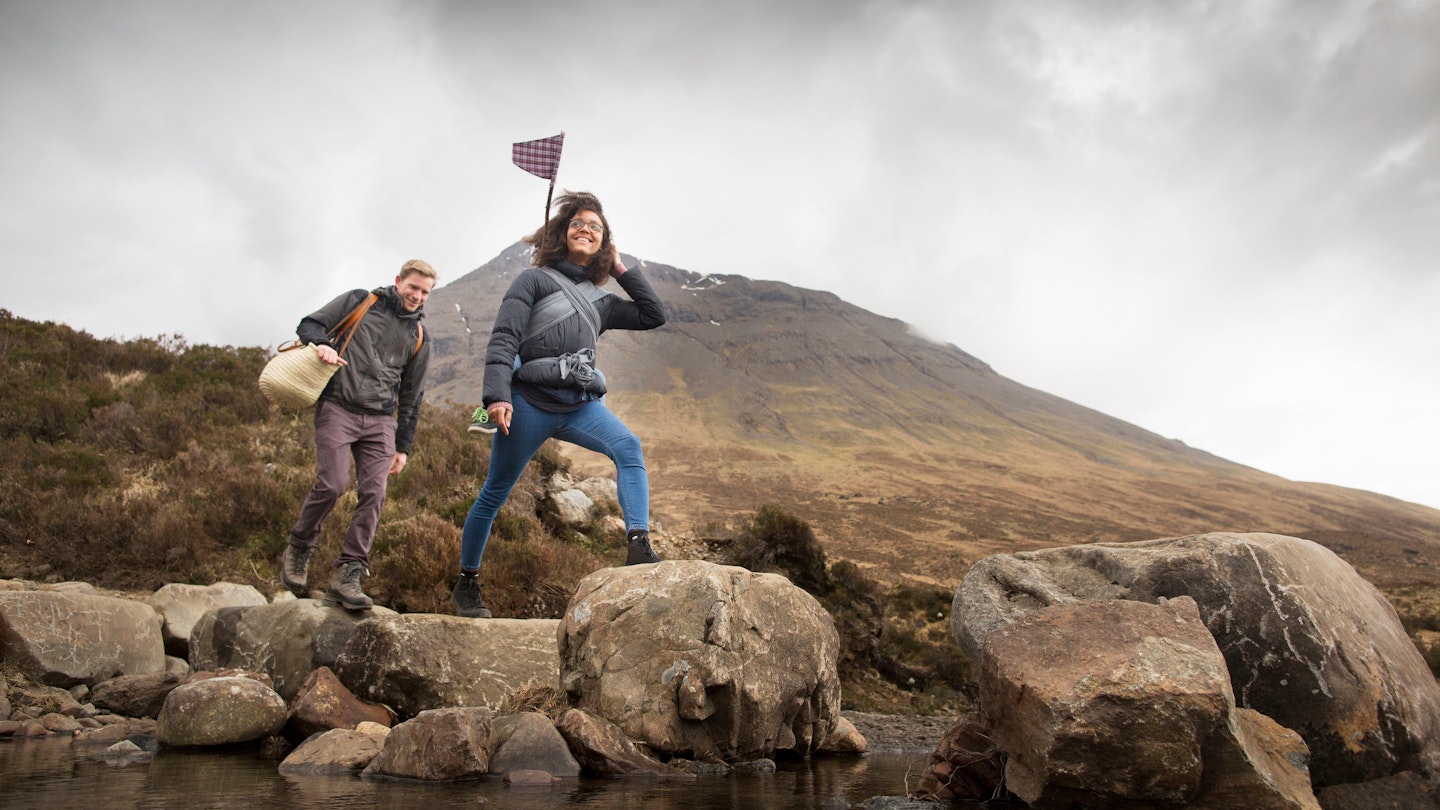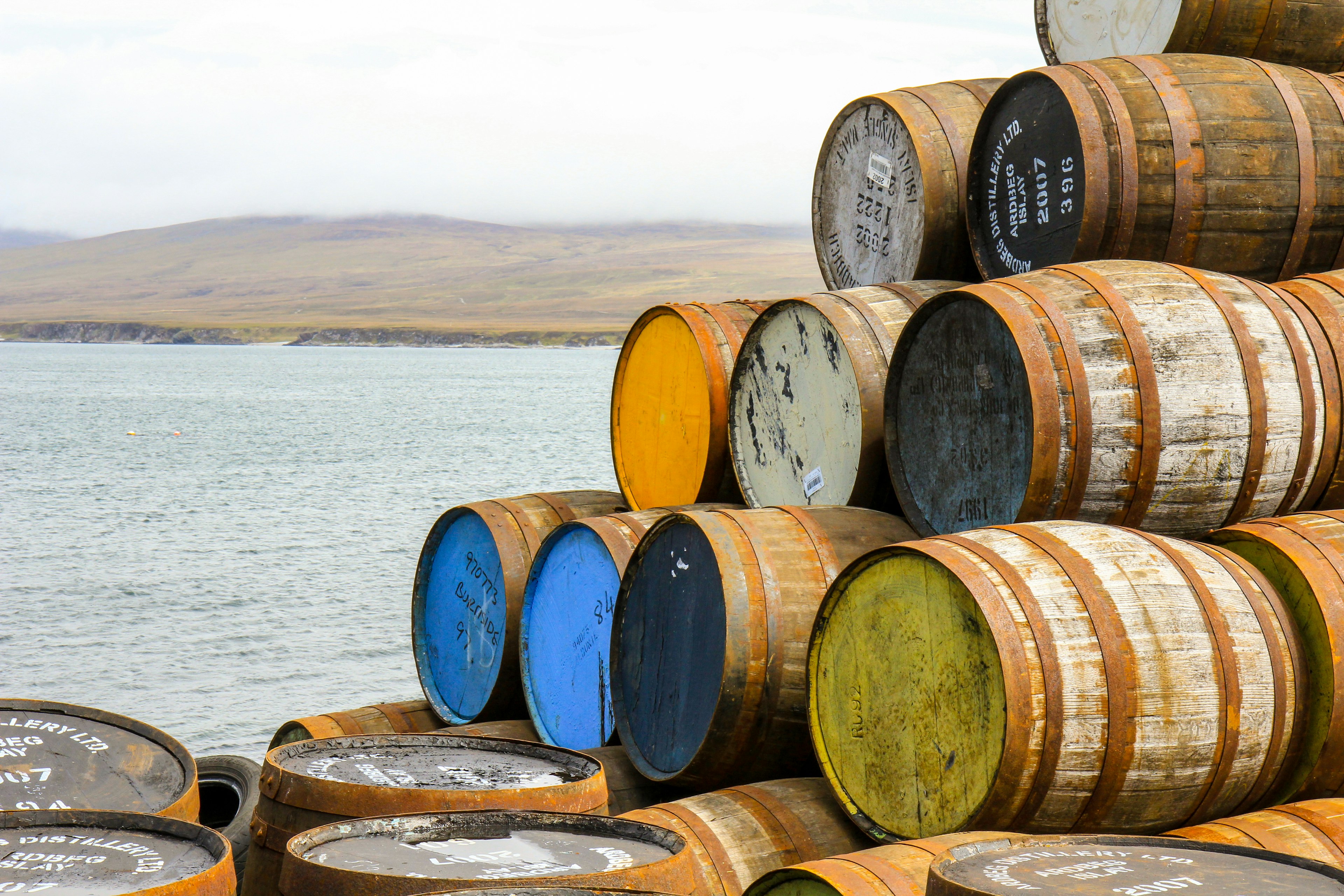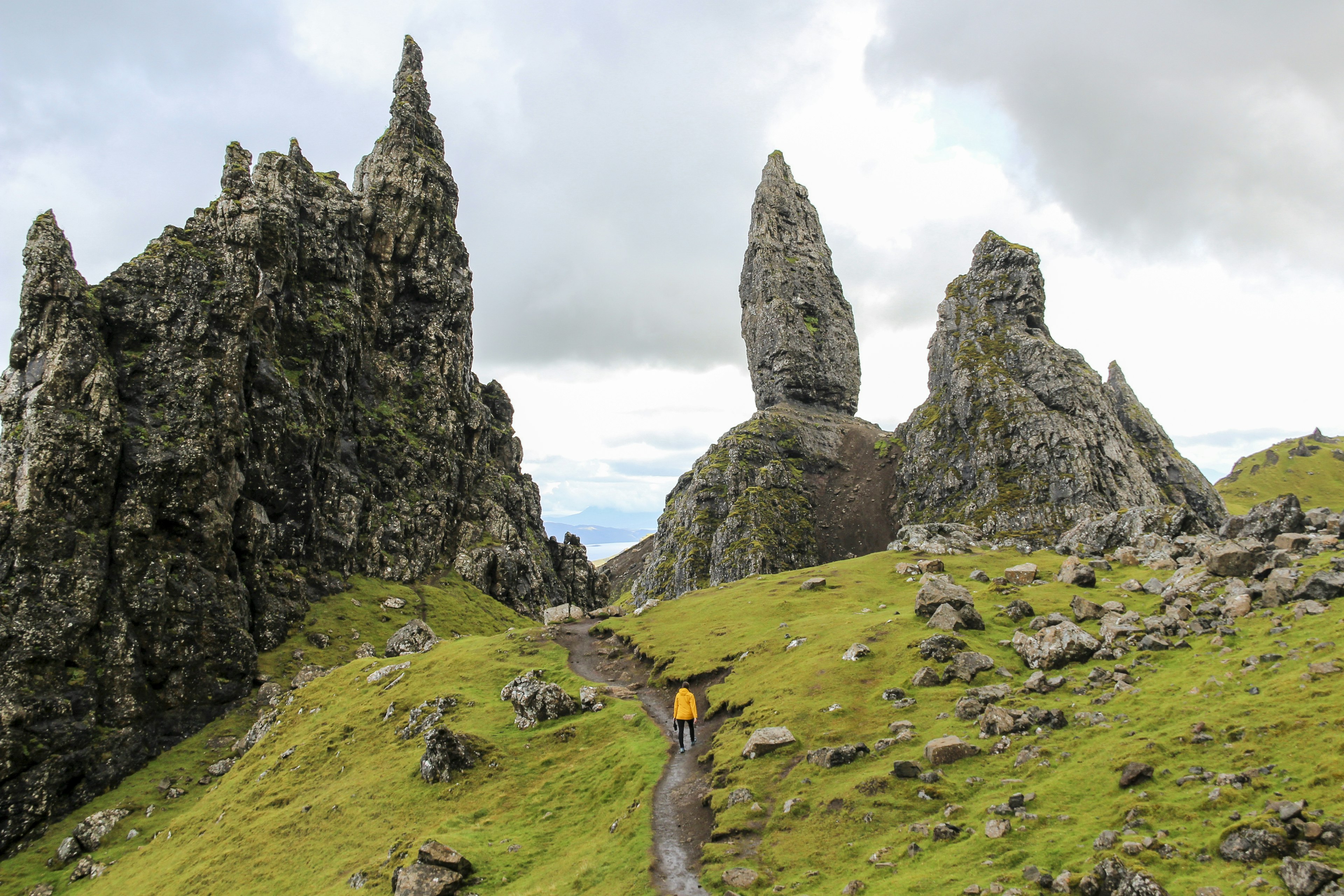
Oct 30, 2024 • 9 min read


Crossing a river near the Fairy Pools on the Isle of Skye © Leon Harris/Getty Images
An emerald shore receding behind, a sea breeze in your face, a dolphin surfing the bow wave as escort. The magic begins as soon as you board the ferry from Scotland’s rugged west coast and head for Scotland's Hebrides islands.
This scattering of more than 50 inhabited and uninhabited islands, islets and skerries is like a world unto itself – thrillingly isolated, wind-battered, sea-smashed and with a beauty that is off the charts. From the ragged mountains of Skye to the snow-white beaches and cerulean seas of Harris, the mysterious standing stones of Lewis to the whisky heaven of Islay, these islands lift spirits in every possible sense of the expression.
Some of Europe’s most alluring beaches are on these Scottish islands (but you’ll need to be made of stern stuff to brave the waters and don’t expect to return home with a tan), while remoteness and underpopulation mean that wildlife displaced elsewhere still flourishes. You’re almost guaranteed to see seals and whales; otters, dolphins and porpoises are also regularly sighted. Seabirds – gannets, fulmars, puffins and more – thrive on jagged coasts, and geese of various species often outnumber residents. That very same isolation – Edinburgh seems another world, and London is outside the Hebridean solar system – means that life has traditionally been a tough, self-reliant affair.
Visiting the Hebrides is about being outdoors. Throughout the islands, there’s great walking, from pacing the sublime sandy beaches of Barra, Tiree or Harris to tackling the rugged challenge of Skye’s Cuillin Hills or the Paps on Jura. To get out on the water, sea-kayaking is a great option on Barra, Skye and other islands. Bicycles are easily taken on ferries, though high winds can make for tough pedaling at times. So lace up the hiking boots, grab binoculars or a paddle, fortify yourself with a local dram and throw yourself into the wilds no matter what hand the weather deals you.
{
"url": "hebrides-scotland-islands",
"destination": "Scotland",
"continent": "Europe",
"country": "Scotland"
}
Mellow, relaxed and so friendly that even passing strangers stop for a wee chat, Islay (‘eye-la’) is the home of several of the world’s best whiskies – many famed for their peatiness – whose names reverberate on the tongue like a pantheon of Celtic deities: Ardbeg, Laphroaig, Lagavulin, Caol Ila, Bunnahabhain, Kilchoman, Bruichladdich, Bowmore.
Wilder and more rugged, the adjacent island of Jura likes long, dark and low off the coast like a Viking longship and provides a tremendous hit of scenery, with its brooding twin hills, the Paps, providing habitat for an enormous deer population. The ferocious Corryvreckan whirlpool churns away at the north of the island, near where George Orwell wrote 1984. The author summed it up neatly as “a very un-get-at-able place”.
Top billing goes to the distilleries on Islay and Jura, which have whisky enthusiasts in raptures, among them Ardbeg, with its magnificent 10-year-old, Bowmore, which malts its own barley, Laphroig, where you can taste famously peaty whiskies, and the Isle of Jura Distillery. All welcome visitors and run tours and tastings. More expensive tours throw in more malts and take you further behind the scenes. It’s worth booking in advance online or by calling ahead.
Cracking seafood (langoustines and crabs fresh off the boat, hand-dived scallops, and tasty mussels and oysters), days spent roaming machair-fringed bays lapped by turquoise seas and brilliant wildlife watching (keep an eye out for grey seals, white-tailed sea eagles, barnacle geese and otters) ramp up Islay’s appeal beyond the dram. Hop on Islay Sea Safaris to spot all of Islay and Jura’s distilleries in a single day. Their customized tours from Port Ellen also include birdwatching trips and visits to Jura’s remote west coast and the Corryvreckan whirlpool, one of the most notorious tidal whirlpools in the world.

Accommodation is like gold dust on Islay and Jura for the number of visitors they receive in spring and summer, so always book ahead. Get the best of Islay seafood and whisky, as well as seriously comfortable Victorian accommodation, at the Port Charlotte Hotel, or camp or stay in a self-catering cottage at Kintra Farm amid the dunes at the southern end of Laggan Bay.
Loganair flies up to three times daily from Glasgow to Islay, and Hebridean Air Services operates twice daily on Thursday from Oban to Colonsay and Islay. There are two ferry terminals: Port Askaig on the east coast, and Port Ellen in the south. Ferries are run by CalMac.
A car ferry shuttles between Port Askaig on Islay and Feolin on Jura. There is no direct car-ferry connection to the mainland. From April to September, Jura Passenger Ferry runs from Tayvallich on the mainland to Craighouse on Jura.
Islay & Jura might be for you if: You’re a fan of whisky and wilderness.
Islay & Jura might not be for you if: You’re looking for serious mountains.

All of the islands are ravishing, but Mull really hits the scenic high notes, with wild mountains and spectacularly eroded dropping abruptly to startlingly turquoise waters. From great crags of black basalt to blindingly white sands, this is an island for slowing the pace for a spell and wholeheartedly embracing nature.
Birds of prey glide above the highest peaks, otters can be spotted along the shore, while the west coast is good for watching whales, dolphins and porpoises. You’ll for sure see seals, too, both the Atlantic gray (look for its Roman nose) and the common seal (recognizable by its doggy face).
Mull’s characterful main town, Tobermory, is an instant heart-stealer, with its row of colorful houses, Hebridean Whale & Dolphin Trust spotlighting local marine life, bijou distillery, excellent restaurant serving sustainable seafood and good old-fashioned pub, near the pier on the harbourfront. Even here, the focus is on the wild outdoors, with hillwalking, whale-watching excursions and boat trips to weird Fingal’s Cave, a 60m-deep chasm of hexagonal pillars, on uninhabited Staffa.
{
"url": "hebrides-scotland-islands",
"destination": "Scotland",
"continent": "Europe",
"country": "Scotland"
}If you’re up for more, you could clamber up 966m Ben More, Mull’s highest peak, and the only island Munro outside Skye, for stirring views out across the islands. Or grab your hiking boots for the adventurous eight-mile return stomp to the phenomenal rock formations of the Carsaig Arches at Malcom’s Point.
A five-minute ferry ride from Fionnphort on Mull, the holy island of Iona weaves its own spell. St Columba sailed from Ireland and landed here in 563, establishing a monastic community with the aim of Christianizing Scotland. Its scriptorium produced some of the most important illuminated manuscripts of the period, including, allegedly, the Book of Kells now in Dublin’s Trinity College. Dotted with majestic stone crosses and monastic ruins, this emerald teardrop of an island is now a place for solitude seekers and pilgrims. The heavily restored abbey is the island’s spiritual heart.
There’s plenty of charming places to stay on Mull, from back-to-nature campsites to B&Bs and luxurious small hotels. For something fancier, Highland Cottage in Tobermory is enchantingly intimate, with antique-filled rooms and a hearty welcome. On a working sheep croft at Iona’s northern tip, the Green Shed is lovely, with eco-friendly self-catering digs decorated with flair and upcycled furniture and riveting sea views.
CalMac has three car ferries that link Mull with the mainland: Oban to Craignure (the busiest route), Lochaline to Fishnish and Tobermory to Kilchoan.
Mull & Iona might be for you if: You love wildlife, mountains and ancient abbeys.
Mull & Iona might not be for you if: You want to just rock up without booking ahead.

The Vikings called it sky-a, or ‘cloud island’, in old Norse, alluding to the clouds that often hovered above the menacing Cuillin Hills, which entice hardcore hikers and mountaineers with some of Scotland’s gnarliest peaks and dizzying views. But even seen from ground level, the Isle of Skye is just stunning. An ethereal light squeezes through the clouds and bathes a rugged splendor that stretches across heather-brushed moors, glittering lochs and sea cliffs razoring above pounding surf.
Skye delivers the kind of big wilderness for which Scotland is so famous – and all neatly packaged into one island. But it’s no secret, so dodge the biggest crowds (and midges) by visiting in spring or autumn. That said, most visitors stick to Portree, Dunvegan and Trotternish – you can always find peace if you’re willing to venture further afield.
Bring your boots. Hikers are in their element with some of the roughest, toughest and most soul-stirring trails in the country. Ease yourself in gently on short hikes through the remote, boggy, loch-speckled, strikingly beautiful glens of Strath Mor, keeping an eye out for red deer and otters, or on moderately challenging ramble to the Old Man of Storr, an iconic pinnacle of crumbling basalt on the Trotternish Peninsula. Or throw yourself in at the deep end with a pulse-racing, nerve-jangling five-mile trek up 992m Sgùrr Alasdair, the loftiest peak in the Black Cuillin, where dark, fierce fangs of rock punch above the sea. Its summit has sensational views all the way to the isles of Rhum, Eigg and Canna. For rock climbers, the Inaccessible Pinnacle (In Pinn) is the Holy Grail. You might need a guide.
The secluded coves and sparkling sea lochs indenting Skye’s coast are best seen with your bum in a kayak and a paddle in your hand, some say. Whitewave Outdoor Centre and Skyak Adventures get you out on the water.
The outdoors is the big draw, for sure, but when the mist descends or the dreich weather blows in, there’s still plenty to do, from castles like mighty Dunvegan on the vast MacLeod Estate to the fascinating Skye Museum of Island Life, zooming in on the island’s crofting heritage, and jolly pubs where you can shelter from the drizzle with a pint.
Skye is insanely popular and accommodation is therefore plentiful, from camping and glamping to backpacker hostels and high-end hotels. Nevertheless, you should book ahead. Harborside Portree is Skye’s largest and liveliest town, with options ranging from simple, homely B&Bs to the luxe Cuillin Hills Hotel, with broad views out to sea and up to the mountains.
Housed in the old village school, Skyewalker Hostel in Minginish has a cool mix of rooms, glamping huts and a glass-domed outdoor seating area.
Skye became permanently tethered to the Scottish mainland when the Skye Bridge opened in 1995. The crossing is free. There are buses from Glasgow to Portree and Uig via Crianlarich, Fort William and Kyle of Lochalsh, plus a service from Inverness to Portree.
{
"url": "hebrides-scotland-islands",
"destination": "Scotland",
"continent": "Europe",
"country": "Scotland"
}Despite the bridge, there are still a couple of ferry links between Skye and the mainland. Ferries also operate from Uig on Skye to the Outer Hebrides. The CalMac ferry between Mallaig and Armadale is very popular on weekends and in July and August. The Glenelg–Skye Ferry runs a tiny vessel (six cars only) on the short Kylerhea to Glenelg crossing.
Skye might be for you if: You are mad about big mountains and hardcore hiking.
Skye might not be for you if: You want to totally escape the crowds.

When the sun breaks through the clouds on Outer Hebrides (or Western Isles), illuminating the velvet pleats of mountains, bracken-cloaked moors and machair-draped dunes that drop to frost-white sands fizzing into a sea of exquisite turquoise, it’s like witnessing the dawn of creation. Far removed from civilization, there are times you will feel like the last soul on earth here, especially if you come in the hush of spring or autumn. Times when you will forget the century we live in, walking barefoot on mile-long beaches made afresh by the tides, looking for otter footprints, witnessing a fiery sunset after a storm, or foraging for cockles and mussels in rocky bays.
These glorious isles – some just wee specks of rock – are isolated, windswept, treeless places that have traditionally subsisted on fishing, weaving and livestock, though renewable energy is increasingly big business. You’ll hear the gentle lilt of Scottish Gaelic everywhere here as it’s still a working language.
The principal island, its northern half called Lewis and its southern Harris, is a terrific starting point, with out-of-this-world coastal scenery, traditional turf-roofed blackhouses, lonely peat bogs dimpled with lochans and the famous Harris tweed.
Mountainous and virtually roadless, North Harris is the hiking dream. South Harris by turn beguiles with staggeringly lovely white-sand beaches like Luskentyre and Scarista, swirling into jade waters. They are all the more enchanting for often being deserted.
Heading to the far northern tip of Lewis brings you to the lighthouse-topped Butt of Lewis, battered by the North Atlantic. The hinterland is largely desolate peat moorland, glittering with lochans. The island is littered with mysterious prehistoric sites, most famously the late-Neolithic standing stones of Callanish, weighing in at some four and a half millennia, roughly contemporary with the Great Pyramid of Giza, and Dun Carloway, a 2000-year-old, dry-stone broch.
To the south, the lonely Uist islands are prime nature-watching territory and connected by a causeway, while little Barra offers memorable sea-kayaking and the chance to watch the Glasgow flight land on the beach.
Given how remote they are, there’s a surprisingly great assortment of places to stay in the Outer Hebrides, from basic campsites and hostels to B&Bs, sleek, architect-designed hotels and eco-friendly beach houses. A lot of accommodation swings with the seasons, closing down during the dark, rainy months from October to March. For hostels with a dash of history and incredible views, check out the Gatliff Hebridean Hostels Trust. Or if you fancy staying in a conserved village of traditional blackhouses on the Isle of Lewis, with the crashing Atlantic as your wake-up call, try Gearrannan Holiday Cottages.
Loganair flights operate to Stornoway from Edinburgh, Inverness and Glasgow. There are also flights (weekdays only) between Stornoway and Benbecula. There are daily Loganair flights from Glasgow to Barra, and from Monday to Saturday to Benbecula. At Barra, the planes land on the hard-sand beach at low tide, so the schedule depends on the tides.
There are two or three CalMac ferries a day to Stornoway, one or two a day to Tarbert and Lochmaddy, and one a day to Castlebay and Lochboisdale (always weather permitting – it can get wild out here!).
The Outer Hebrides might be for you if: You love wild scenery, beaches and prehistory.
The Outer Hebrides might not be for you if: You want more action – it’s remote and quiet here.
{
"url": "hebrides-scotland-islands",
"destination": "Scotland",
"continent": "Europe",
"country": "Scotland"
}

Oct 30, 2024 • 9 min read

Oct 15, 2024 • 8 min read

Oct 15, 2024 • 9 min read





